Anne Hidalgo, Mayor of Paris
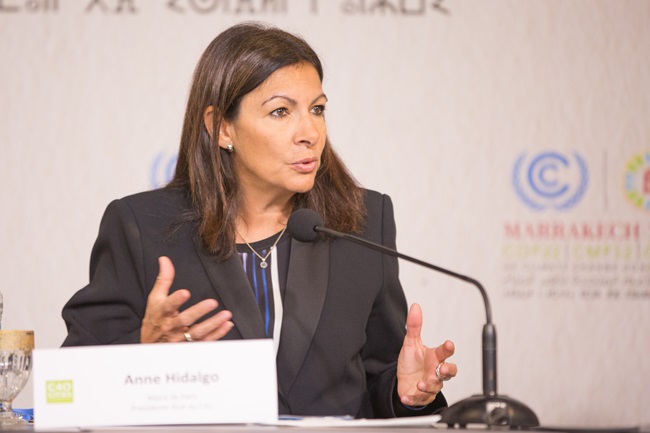
It’s been said, “Small minds discuss people; average minds discuss events; great minds discuss ideas.” Mayor Anne Hidalgo, recently named to Time’s 100 Climate List for 2024, is an ideas-woman and one can extrapolate from there.
Mayor of Paris since 2014, Anne Hidalgo is an upsetter, a non-conformist with an eye to the future. Hidalgo makes the most of her city; by immersing herself in the rhythm of the streets, she has a personal view as to what needs improving. During her term in office, Anne Hidalgo’s ideas have put Paris at the forefront of the fight against climate change at an urban level. Her plans included the construction of hundreds of kilometers of bike lanes, the transformation of the banks of the Seine, banning traffic in certain areas of the capital, and incorporating the 15-minute city idea into urban planning.
Spanish by birth, Ana María Hidalgo Aleu was born in 1959 in the southern town of San Fernando, to Antonio and Maria Hidalgo. Her grandfather, a left-leaning supporter of the Spanish republic, evaded execution during the reign of the fascist dictator Franco. The family fled to France, in search of a better life, where the country’s democracy appealed to the Hidalgo’s beliefs. At the age of two, her family settled in the working-class Vaise neighbourhood of Lyon, where Antonio, an electrician, found factory work. Her father’s trade unionism and the family’s principles worked to shape Hidalgo’s socialist beliefs.
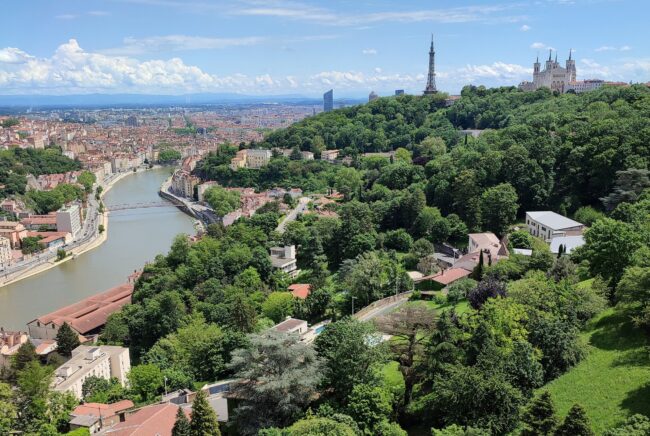
The city of Lyon, France. Photo credit: Aldg692VX / Wikimedia commons
A citizen of both France and Spain, Ana Hidalgo surrendered her Spanish nationality at 14 when she became a naturalized French citizen and changed the spelling of her name to Anne. Anne Hidalgo has every right to talk about immigration and inequality. She wrote in her memoir Mon Combat pour Paris (My Fight for Paris) that she grew up in a multilingual, working-class housing estate in Lyon, where Armenian, Portuguese, Italian, Russian, and North African neighbors created a community out of their towers of babel. Her youth in an underprivileged neighborhood taught Hidalgo valuable lessons in town planning and social housing.
Hidalgo escaped what she described as a “rabbit cage” of low-rent buildings. She was a clever student and drew on her family’s struggle for democracy while studying social law at Lyon’s Jean Moulin University. While obtaining her masters degree in social and trade unionism at Université Paris-Nanterre, she married her first husband, Philippe Jantet, a fellow student and political activist, when she was just 20.
In 1982, Hidalgo passed the exams to become a labor inspector – a civil servant who ensures that labour law is correctly applied by employers. She held her own in the largely male-dominated environments of factories, mines, and small-town politicians. The work suited her left-wing sympathies.
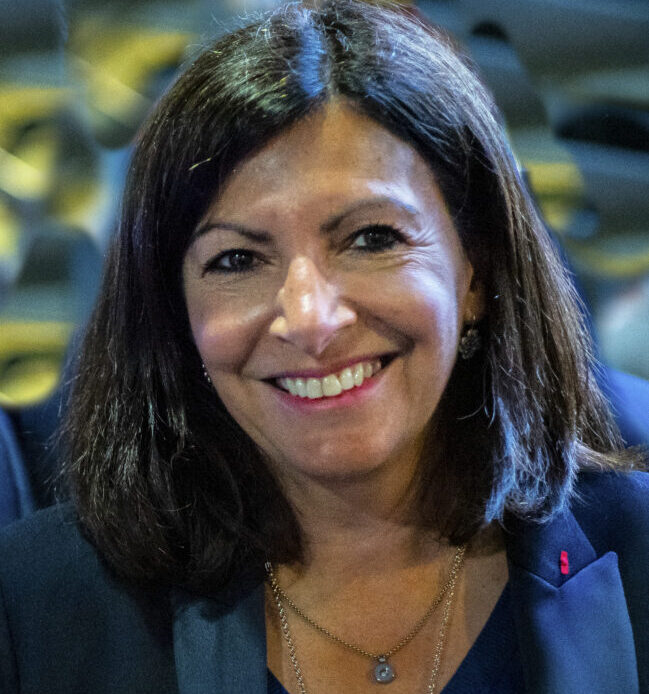
Anne Hidalgo in 2020. Photo credit: Jacques Paquier / Wikimedia commons
Hidalgo and Jantet had two children: Matthieu, born 1986, is now a lawyer, and Elsa, born in 1988, is an engineer. The couple divorced in 1995. Hidalgo met her current husband, Jean-Marc Germain, in the late ’90s, while both employed at the Ministry of Labor. Between 1997 and 2001, Hidalgo worked as a staffer in three federal ministries, with a portfolio of job parity. Then entering the arena of local politics she was elected councillor in the 15th arrondissement, where today she and Germain still reside.
At 42, Anne Hidalgo, pregnant with her third child, Arthur, opted not to take maternity leave, instead forging ahead in support of the mayoral race of Bertrand Delanoë, a candidate from the Parti Sociale. An historical win for the political Left, Delanoë appointed Hidalgo as the deputy mayor of Paris, a position she held from 2001 to 2014.
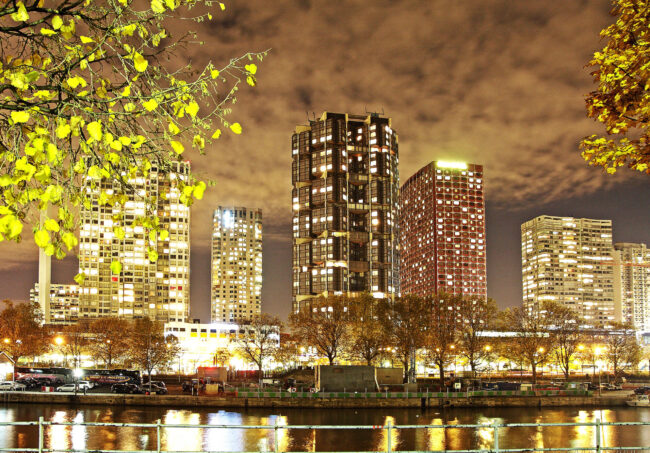
The Front de Seine development in the 15th district of Paris. Photo credit: Jean-François Gornet / Wikimedia commons
The following year, Delanoë was critically stabbed at a public gathering. While he convalesced, Hidalgo assumed his functions, which served to increase her public exposure; she was not well recognized outside the Hotel de Ville. In 2012, with Delanoë ready to stand down, Hidalgo announced that she would stand for the 2014 mayoral elections. To the surprise of her opponents, she promoted herself as a moderate, and won. On 5 April 2014, she was elected as mayor of Paris. The first woman to hold the post, Hidalgo was now responsible for 2.1 million inhabitants, a budget of 8 billion euros, and a municipal workforce of over 45,000.
During her first term, Hidalgo launched Réinventer Paris, a citywide program aimed at refurbishing public spaces and reusing obsolescent and unloved parts of the city. Since Hidalgo took office, Paris has created community housing for 7,000 families.
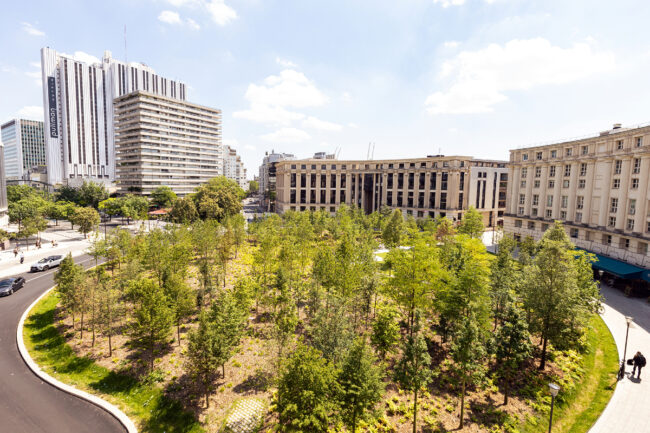
An “urban forest” planted on the place de Catalogne in 2023-2024. Photo: Guillaume Bontemps/ Ville de Paris
From the start of her mandate, Hidalgo declared war on Paris traffic, blaming it for pollution and climate change. She’s believes that cities need to play their part in keeping global warming levels to below 1.5°C by the end of the 21st century. As of January 1, 2025, her municipal government is banning older (and more polluting) diesel and gas powered cars from entering the periphery of Paris. Even more ambitious is a potential ban on gas-driven cars by 2030. She introduced an idea called “Paris Respire” (“Paris Breathes”), which banned traffic from certain zones on Sundays. More recently, a swathe of central Paris has been converted into a low-traffic zone. In doing so, she has infuriated car owners, however less than 35% of Parisians claim to own a car. Despite opposition, Hidalgo has removed traffic from the banks of the Seine; now it is a pleasant waters-edge path for the use of pedestrians and cyclists.
Hidalgo was re-elected in 2020, campaigning with the proposal to turn Paris into a 15-minute city. In the “15-minute city,” an idea by academic and urbanist Carlos Moreno, residents have access to all basic services – public transport, shops, schools, even work – within a quarter-hour-long walk, or bike ride, from their home. The pandemic proved it possible to work differently, and perhaps this idea is viable. Hidalgo further used Covid-19 to reshape the city. Hidalgo already had an eye to make Paris 100% bikeable, and had pop-up cycle lanes – coronapistes – installed around the city. The increase in biking has removed people from crowded public transport while lessening the car demand.
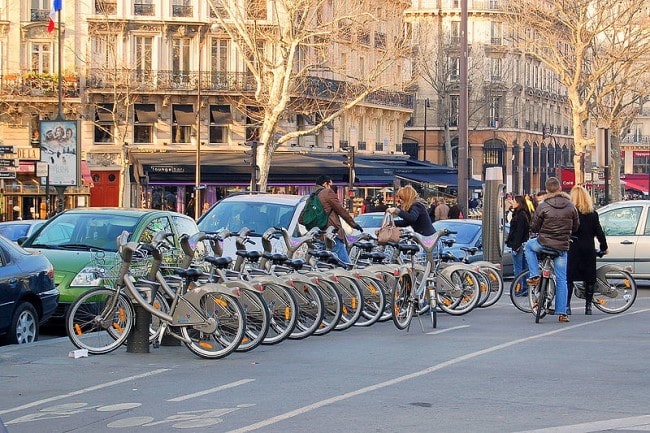
Cycling in Paris.
In January 2021, the city initiated a new green initiative to plant 70,000 trees by the end of 2026. Hidalgo even proposed to transform the Champs-Elysées into a tunnel of green. Paris received a Climate Action Award from the UN during COP26 for its exceptional climate leadership.
Anne Hidalgo was in office during the terrorist attacks on Charlie Hebdo, and the Bataclan in 2015. She was also the city’s boss when fire gutted Notre Dame in 2019. During her first term, the city of Paris won the bid to host the 2024 Olympic and Paralympic Games, but Hidalgo’s mind was often brought back to the vicious attacks of 2015 and was determined nothing would damage the city or its reputation. Thankfully, there were no violent instances.
Instead, the Olympics served to advance Hidalgo’s legacy. Many of her ideas for the greening of Paris were pushed through. As one of the main faces of the organization, she took an ever-so brief swim in the Seine to prove it was clean enough for events. She was perhaps inspired to take the plunge by her son Arthur, who is not only the youngest French person to swim the English Channel, but also the first person to swim the length of the Seine! The river was the star of the opening ceremony as the athletes were carried down it in a flotilla of boats, and the river was used for the triathlon and marathon swimming events.
It was said by erstwhile London Mayor and British Prime Minister Boris Johnson that being the mayor of a host Olympic city was a good springboard into international politics. However, when Hidalgo announced her candidacy in the 2022 presidential elections, she came 10th out of 12 candidates. It is possible that Anne Hidalgo’s appeal is found only in Paris. Her politics are urban and her ecological ideas hard to expand beyond the capital.
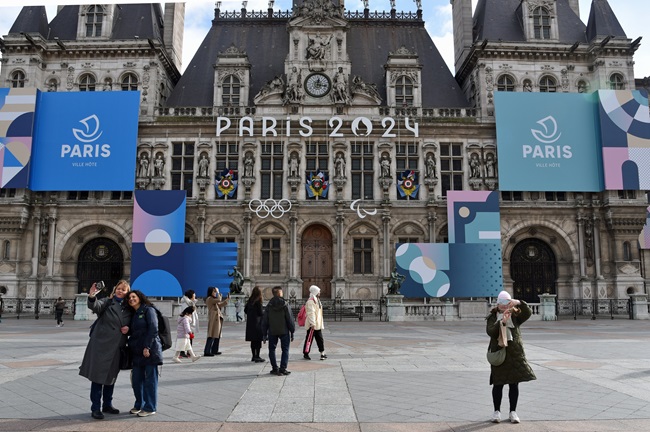
Paris Olympics. Photo: Conall/ Flickr
Anne Hidalgo gets things done, whether you love her policies or hate them. Her detractors are many. Her deputy Mayor Bruno Julliard surprisingly resigned in 2018, criticizing Hidalgo’s style of governance. Car-dependent citizens are enraged with narrow lanes, congestion, and blocked access. Although Hidalgo wishes to maintain a city with heritage and history, many aren’t happy with her reinvention of Paris. They call her an out-of-touch –bohemian –bourgeois who’s trying to turn Paris into a fairy-tale city. She has also been condemned as a controlling Stalinist and called a member of the “KhmerVert – a totally inappropriate name for what is seen as environmental communism. Detractors take umbrage with a large property tax hike too. Her popularity ebbed during Covid, in no small part from nightly curfews and the closure of non-essential businesses. She’s not universally liked, but can’t be faulted for what she’s accomplished.
Hidalgo says that her raison d’etre is to offer all Parisians an excellent quality of life. Her ideas have transformed Paris into a city with open spaces for pedestrians, new green areas, and four times more cycle lanes. Car numbers and air pollution are down more than 40% from a decade ago. Her term expires in 2026.
Lead photo credit : Paris Mayor Anne Hidalgo. Photo: UNclimatechange/ Flickr
More in Anne Hidalgo, Mayor



REPLY